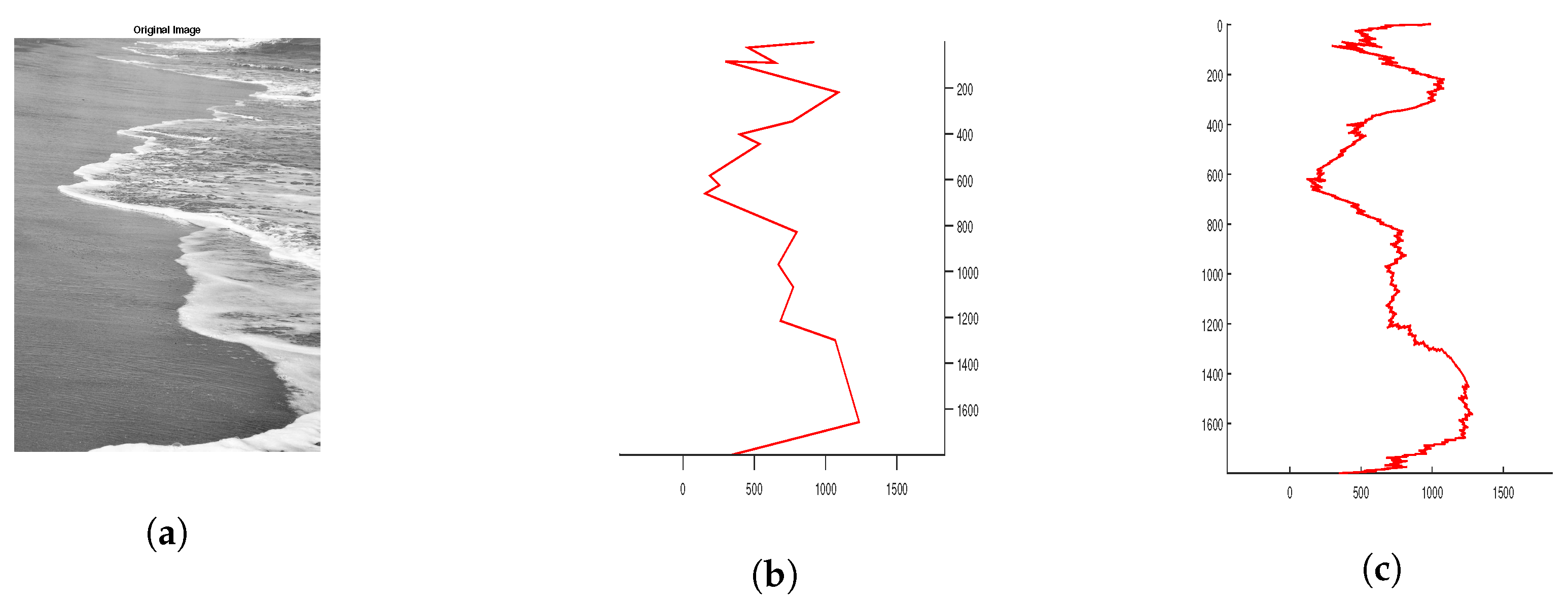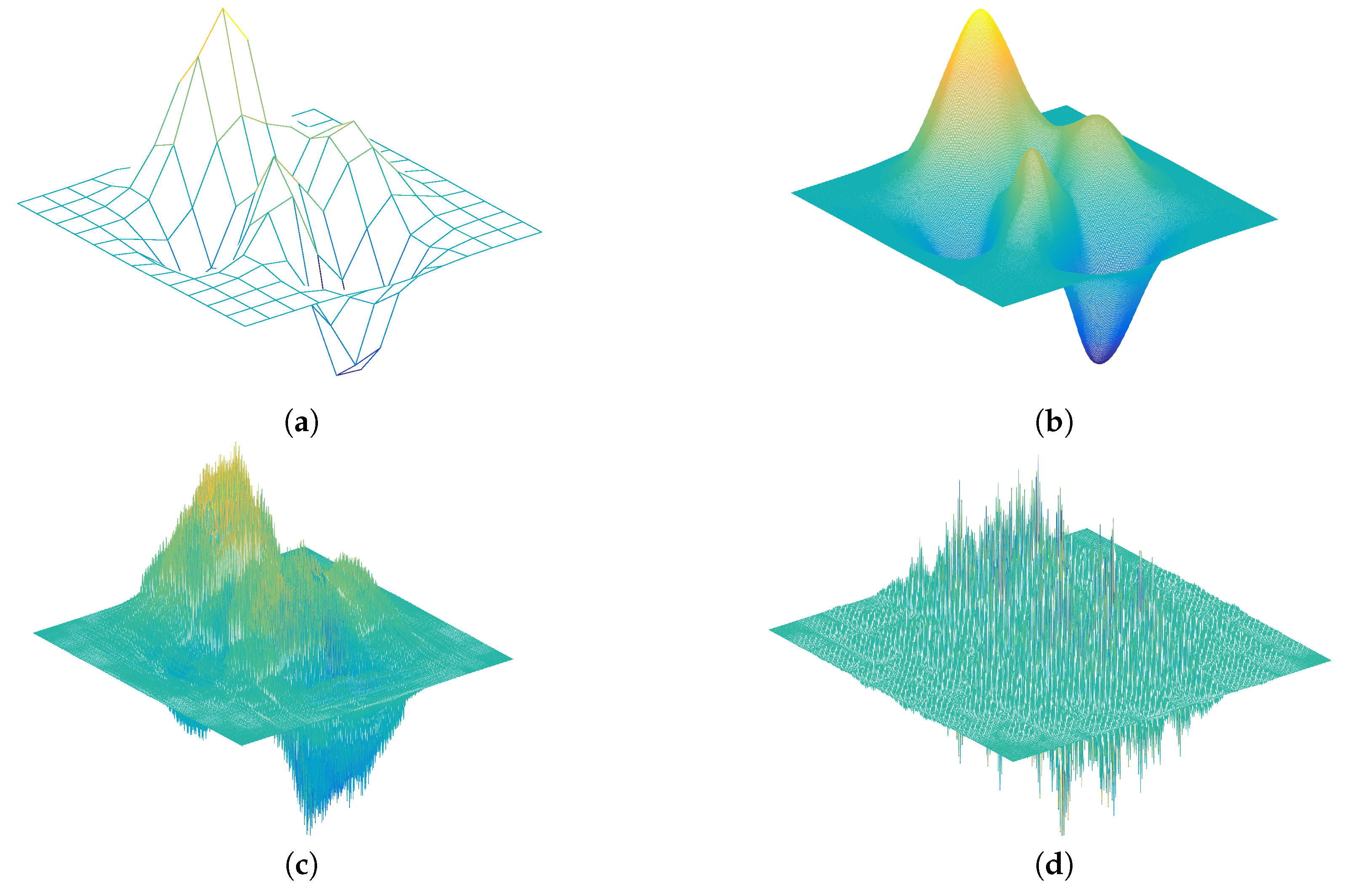Fractal Behavior of a Ternary 4-Point Rational Interpolation Subdivision Scheme
Abstract
:1. Introduction
2. Preliminaries
3. Rational Interpolation Subdivision Scheme
4. Continuity Analysis
4.1. Necessary Condition
- The eigenvalues for A are
- The eigenvalues for B are
4.2. Sufficient Condition
5. Fractal Behavior
6. Example
7. Conclusions
Author Contributions
Acknowledgments
Conflicts of Interest
References
- Dyn, N.; Levin, D.; Gregory, J.A. A 4-point interpolatory subdivision scheme for curve design. Comput. Aided Geometric Design 1987, 4, 257–268. [Google Scholar] [CrossRef]
- Hassan, M.F.; Ivrissimtzis, I.P.; Dodgson, N.A.; Sabin, M.A. An interpolating 4-point ternary stationary subdivision scheme. Comput. Aided Geometric Design 2002, 19, 1–18. [Google Scholar] [CrossRef]
- Mustafa, G.; Irum, J.; Bari, M. A new 6-point ternary interpolating subdivision scheme and its differentiability. J. Comput. Inf. Sci. Eng. 2010, 5, 199–210. [Google Scholar] [CrossRef]
- Mustafa, G.; Irum, J.; Bari, M. A new 5-point ternary interpolating subdivision scheme and its differentiability. ISRN Comput. Math. 2012, 2012, 1–10. [Google Scholar] [CrossRef]
- Siddiqi, S.S.; Rehan, K. Symmetric ternary interpolating subdivision scheme. Int. Math. Forum 2012, 7, 2269–2277. [Google Scholar]
- Siddiqi, S.S.; Ahmad, N.; Rehan, K. Ternary 4-point interpolating scheme for curve sketching. Res. J. Appl. Sci. Eng. Tech. 2013, 6, 1556–1561. [Google Scholar] [CrossRef]
- Hassan, M.F.; Dodgson, N.A. A Ternary and Three-point Univariate Subdivision Schemes. Available online: http://neildodgson.com/pubs/Hassan-StMalo02-paper.pdf (accessed on 22 August 2018).
- Ko, K.P.; Lee, B.G.; Yoon, G.J. A Ternary 4-Point Approximating Subdivision Scheme. Appl. Math. Comput. 2007, 190, 1563–1573. [Google Scholar] [CrossRef]
- Ghaffar, A.; Mustafa, G. The family of even-point ternary approximating schemes. ISRN Appl. Math. 2012, 1, 1–14. [Google Scholar] [CrossRef]
- Rehan, K.; Siddiqi, S.S. A family of ternary subdivision schemes for curves. Appl. Math. Comput. 2015, 270, 114–123. [Google Scholar] [CrossRef]
- Zheng, H.; Ye, Z.; Lei, Y.; Liu, X. Fractal properties of interpolatory subdivision schemes and their application in fractal generation. Chaos Solitons Fractals 2007, 32, 113–123. [Google Scholar] [CrossRef]
- Zheng, H.Y.; Ye, Z.; Chen, Z.; Zhao, H. Fractal range of a 3-point ternary interpolatory subdivision scheme with two parameters. Chaos Solitons Fractals 2007, 32, 1838–1845. [Google Scholar] [CrossRef]
- Siddiqi, S.S.; Ahmad, N. Generation of fractal curves and surfaces using ternary 4-point interpolatory subdivision scheme. Appl. Math. Comput. 2014, 246, 210–220. [Google Scholar] [CrossRef]
- Siddiqi, S.S.; Salam, W.U.; Butt, N.A. Fractal behavior of ternary 4-point interpolatory subdivision scheme with tension parameter. Appl. Math. Comput. 2015, 260, 148–158. [Google Scholar] [CrossRef]





© 2018 by the authors. Licensee MDPI, Basel, Switzerland. This article is an open access article distributed under the terms and conditions of the Creative Commons Attribution (CC BY) license (http://creativecommons.org/licenses/by/4.0/).
Share and Cite
Peng, K.; Tan, J.; Li, Z.; Zhang, L. Fractal Behavior of a Ternary 4-Point Rational Interpolation Subdivision Scheme. Math. Comput. Appl. 2018, 23, 65. https://doi.org/10.3390/mca23040065
Peng K, Tan J, Li Z, Zhang L. Fractal Behavior of a Ternary 4-Point Rational Interpolation Subdivision Scheme. Mathematical and Computational Applications. 2018; 23(4):65. https://doi.org/10.3390/mca23040065
Chicago/Turabian StylePeng, Kaijun, Jieqing Tan, Zhiming Li, and Li Zhang. 2018. "Fractal Behavior of a Ternary 4-Point Rational Interpolation Subdivision Scheme" Mathematical and Computational Applications 23, no. 4: 65. https://doi.org/10.3390/mca23040065
APA StylePeng, K., Tan, J., Li, Z., & Zhang, L. (2018). Fractal Behavior of a Ternary 4-Point Rational Interpolation Subdivision Scheme. Mathematical and Computational Applications, 23(4), 65. https://doi.org/10.3390/mca23040065





